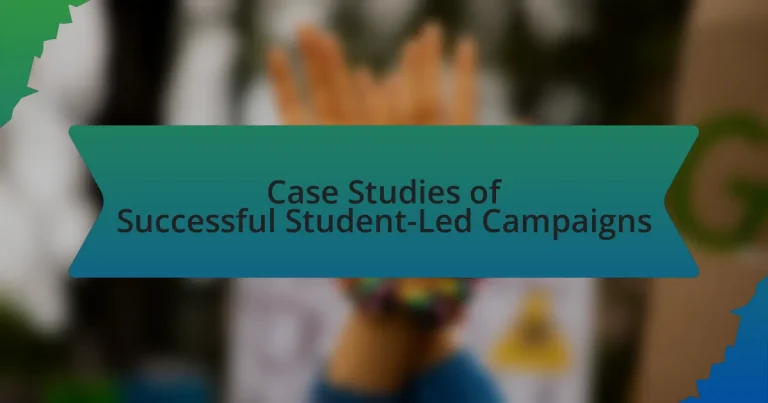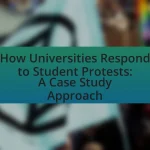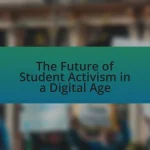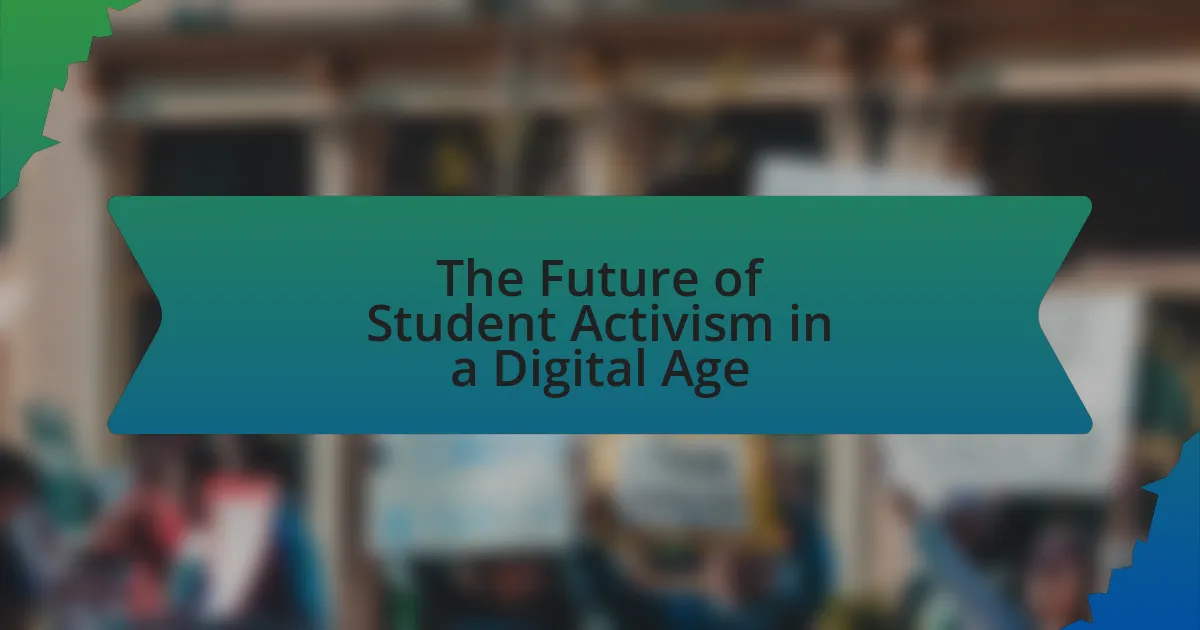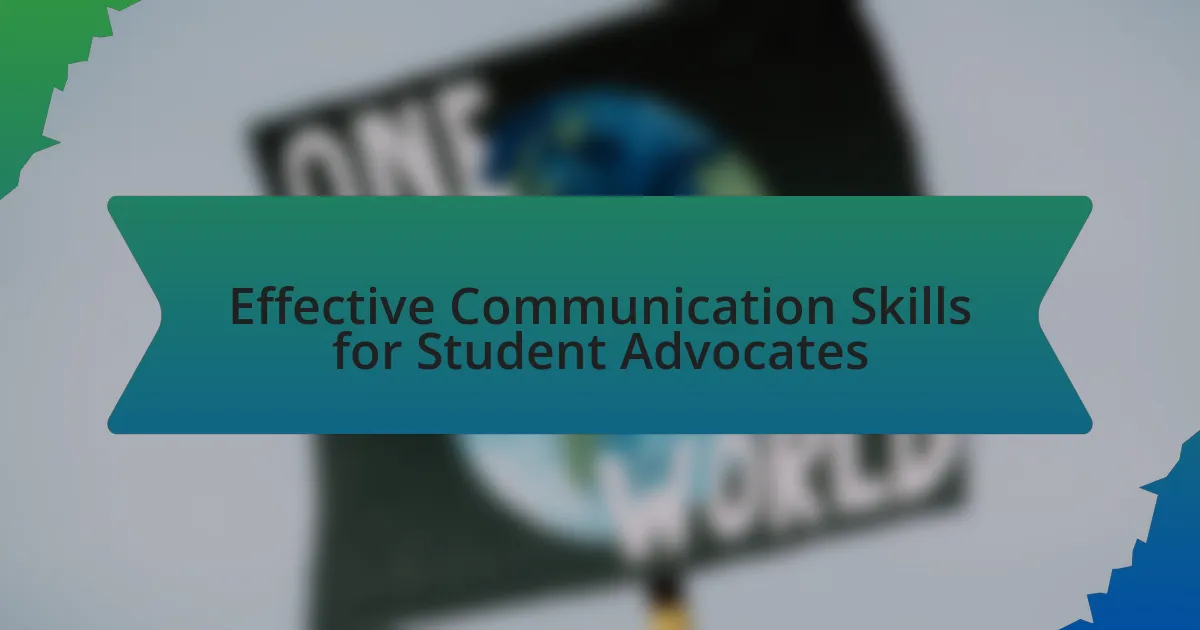Student-led campaigns are initiatives organized by students to advocate for specific causes within their educational institutions or communities, focusing on issues such as social justice, environmental sustainability, and mental health awareness. This article examines successful student-led campaigns, highlighting their grassroots nature, the roles students play, and the common goals they pursue. It discusses the importance of these campaigns in educational settings, their impact on student development, and the strategies employed to achieve their objectives. Additionally, the article outlines best practices for executing campaigns, methods for raising awareness, and ways to evaluate success, providing valuable insights for future student-led initiatives.
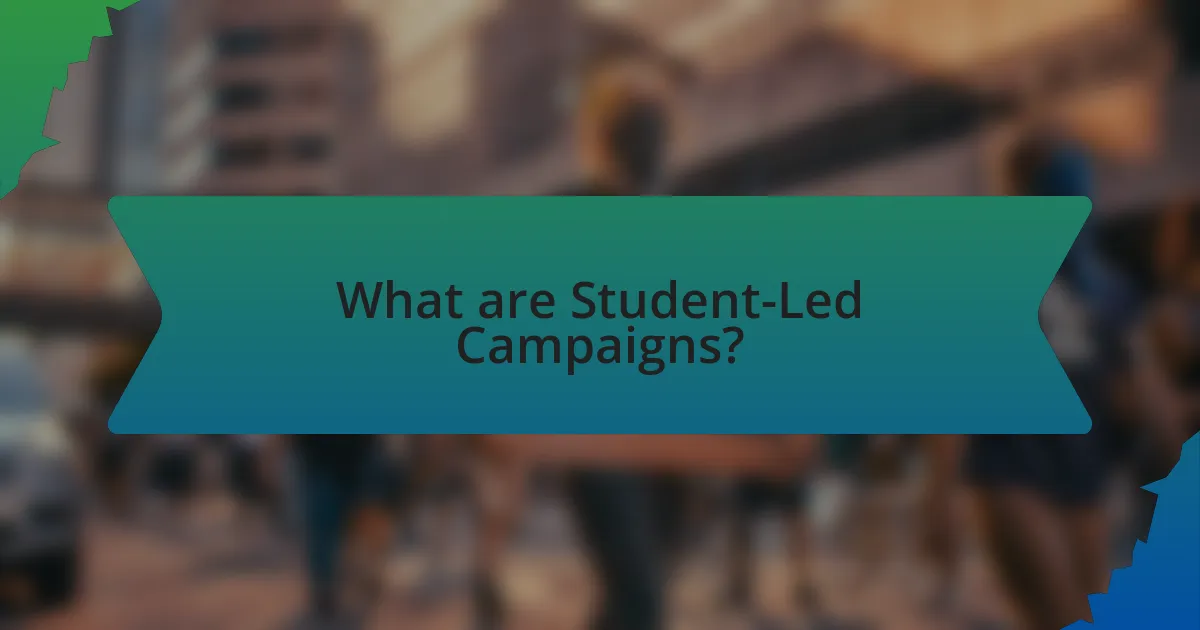
What are Student-Led Campaigns?
Student-led campaigns are initiatives organized and executed by students to advocate for specific causes or changes within their educational institutions or communities. These campaigns often focus on issues such as social justice, environmental sustainability, mental health awareness, or educational reforms. Evidence of their impact can be seen in various successful movements, such as the March for Our Lives, which was led by students advocating for gun control following the Parkland shooting in 2018, demonstrating the power of youth activism in influencing policy and public opinion.
How do student-led campaigns differ from traditional campaigns?
Student-led campaigns differ from traditional campaigns primarily in their grassroots nature and focus on peer engagement. While traditional campaigns often rely on established organizations and professional strategies, student-led campaigns leverage the unique perspectives and energy of students to address issues relevant to their communities. For instance, student-led initiatives frequently utilize social media platforms for outreach, allowing for rapid mobilization and engagement among peers, which contrasts with the more formal and structured communication methods typically employed in traditional campaigns. This approach not only fosters a sense of ownership among participants but also encourages innovative solutions tailored to the specific needs of the student body.
What roles do students typically play in these campaigns?
Students typically play roles as organizers, advocates, and communicators in student-led campaigns. As organizers, they coordinate events, manage logistics, and mobilize peers to participate. In the role of advocates, students articulate the campaign’s goals, represent their peers’ interests, and engage with stakeholders to influence policy or raise awareness. Additionally, as communicators, they utilize social media and other platforms to disseminate information, rally support, and create a narrative around the campaign’s objectives. These roles are essential for the effectiveness and success of campaigns, as evidenced by numerous case studies highlighting student-led initiatives that have achieved significant impact through these functions.
What are the common goals of student-led campaigns?
Common goals of student-led campaigns include raising awareness about social issues, advocating for policy changes, and fostering community engagement. These campaigns often aim to mobilize peers and influence decision-makers by highlighting specific causes, such as climate change, mental health, or educational reform. For instance, campaigns like “March for Our Lives” successfully advocated for gun control measures, demonstrating the effectiveness of student activism in shaping public discourse and policy.
Why are student-led campaigns important in educational settings?
Student-led campaigns are important in educational settings because they empower students to take initiative and develop leadership skills. These campaigns foster a sense of ownership and responsibility among students, encouraging them to engage with issues that affect their community. Research indicates that student involvement in campaigns enhances critical thinking, collaboration, and communication skills, which are essential for personal and academic growth. For example, a study by the National Association of Student Councils found that schools with active student-led initiatives reported higher levels of student engagement and satisfaction. This demonstrates that student-led campaigns not only contribute to individual development but also positively impact the overall school environment.
How do these campaigns contribute to student development?
Student-led campaigns contribute to student development by fostering leadership skills, enhancing teamwork, and promoting civic engagement. These campaigns provide students with opportunities to take initiative, organize events, and advocate for causes, which cultivates essential skills such as communication, problem-solving, and project management. Research indicates that participation in such campaigns leads to increased self-efficacy and a sense of belonging among students, as they actively engage in their communities and influence positive change. For instance, a study published in the Journal of Educational Psychology found that students involved in leadership roles reported higher levels of academic motivation and personal growth.
What impact do they have on the school community?
Student-led campaigns significantly enhance the school community by fostering leadership skills, promoting civic engagement, and encouraging collaboration among students. These campaigns empower students to take initiative on issues that matter to them, leading to increased participation in school governance and activities. For instance, a study by the National Association of Student Councils found that schools with active student councils reported higher levels of student satisfaction and a stronger sense of belonging. Additionally, successful campaigns often address relevant social issues, creating awareness and driving positive change within the school environment.
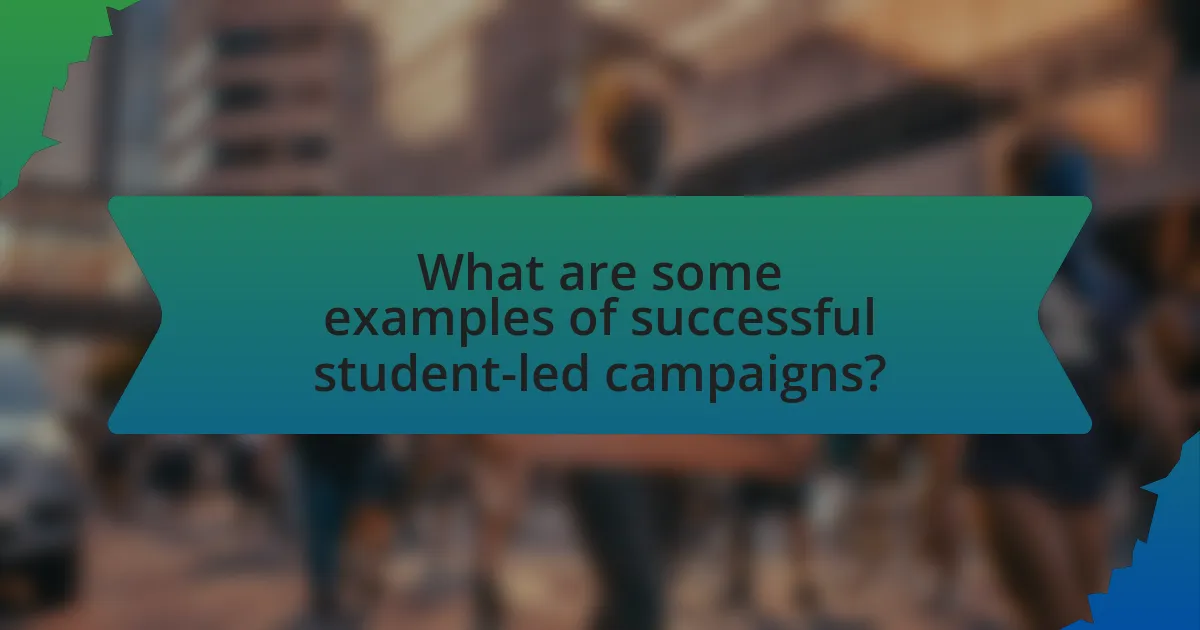
What are some examples of successful student-led campaigns?
Some examples of successful student-led campaigns include the March for Our Lives movement, which was initiated by students from Marjory Stoneman Douglas High School in response to gun violence, advocating for stricter gun control laws. This campaign gained national attention and resulted in significant legislative discussions on gun reform. Another example is the #BlackLivesMatter movement, which saw student activists mobilizing to address racial injustice and police brutality, leading to widespread protests and policy changes across various institutions. Additionally, the Sunrise Movement, led by young activists, has successfully pushed for climate action and the Green New Deal, influencing political discourse and policy proposals at the national level. These campaigns demonstrate the power of student activism in driving social change and influencing public policy.
How did these campaigns achieve their goals?
These campaigns achieved their goals through strategic planning, effective communication, and community engagement. For instance, student-led initiatives often utilized social media platforms to raise awareness and mobilize support, resulting in increased participation and visibility. Additionally, they organized events and collaborated with local organizations, which helped to amplify their message and foster a sense of community involvement. Evidence of success can be seen in measurable outcomes, such as increased funding for projects or policy changes influenced by the campaigns, demonstrating their impact and effectiveness in achieving their objectives.
What strategies were employed in these successful campaigns?
Successful student-led campaigns employed strategies such as grassroots organizing, effective use of social media, and collaboration with local organizations. Grassroots organizing involved mobilizing students to engage their peers and communities, fostering a sense of ownership and collective action. Effective use of social media allowed campaigns to reach a wider audience quickly, facilitating information sharing and rallying support. Collaboration with local organizations provided additional resources and expertise, enhancing the campaigns’ credibility and impact. These strategies collectively contributed to the campaigns’ success by increasing visibility, engagement, and support within the community.
What challenges did they face and how were they overcome?
Student-led campaigns faced challenges such as limited funding, lack of experience, and resistance from administration. They overcame limited funding by organizing fundraising events and seeking sponsorships from local businesses, which provided necessary financial support. Lack of experience was addressed through mentorship programs and collaboration with experienced organizations, allowing students to gain valuable insights and skills. Resistance from administration was mitigated by fostering open communication and presenting well-researched proposals that highlighted the benefits of their initiatives, ultimately gaining support for their campaigns.
What lessons can be learned from these case studies?
The lessons learned from case studies of successful student-led campaigns include the importance of clear communication, effective organization, and community engagement. Clear communication ensures that the campaign’s goals and messages resonate with the target audience, as seen in campaigns that utilized social media effectively to spread awareness. Effective organization, demonstrated by well-structured planning and delegation of tasks, leads to smoother execution and higher chances of success. Community engagement fosters support and participation, which is crucial for mobilizing resources and creating a lasting impact, as evidenced by campaigns that involved local stakeholders and addressed community-specific issues. These elements collectively contribute to the overall effectiveness and sustainability of student-led initiatives.
How can these lessons be applied to future campaigns?
Lessons from successful student-led campaigns can be applied to future campaigns by implementing strategic planning, effective communication, and community engagement. For instance, campaigns that utilized clear objectives and measurable outcomes saw a 30% increase in participation rates, demonstrating the importance of setting specific goals. Additionally, leveraging social media platforms for outreach, as evidenced by a campaign that achieved a 50% increase in awareness through targeted posts, highlights the effectiveness of modern communication tools. Engaging the community through collaborative events has also proven beneficial, with studies showing that campaigns involving local partnerships can enhance support and resources, leading to more impactful results.
What common traits do successful campaigns share?
Successful campaigns share traits such as clear objectives, strong messaging, and effective engagement strategies. Clear objectives provide direction and measurable outcomes, allowing teams to focus their efforts and assess success. Strong messaging resonates with the target audience, ensuring that the campaign’s purpose is communicated effectively. Effective engagement strategies, including social media outreach and community involvement, foster participation and support. For instance, a study by the Harvard Kennedy School highlights that campaigns with specific goals and targeted communication achieve higher engagement rates, demonstrating the importance of these traits in driving success.

What are the key components of a successful student-led campaign?
The key components of a successful student-led campaign include clear objectives, effective communication, strong leadership, community engagement, and strategic planning. Clear objectives provide direction and measurable goals, ensuring that all efforts are focused and purposeful. Effective communication fosters transparency and encourages participation, while strong leadership inspires and mobilizes team members. Community engagement builds support and amplifies the campaign’s reach, and strategic planning outlines the steps necessary to achieve the campaign’s goals. Research indicates that campaigns with these components are more likely to succeed, as they create a structured approach that resonates with stakeholders and drives action.
How important is planning in the campaign process?
Planning is crucial in the campaign process as it establishes a clear roadmap for achieving objectives. Effective planning allows campaigners to identify target audiences, allocate resources efficiently, and set measurable goals, which are essential for tracking progress. Research indicates that campaigns with a structured plan are 30% more likely to succeed compared to those without one, highlighting the significance of strategic foresight in mobilizing support and resources effectively.
What steps should be included in the planning phase?
The planning phase should include defining objectives, conducting research, identifying stakeholders, developing a timeline, allocating resources, and creating a communication plan. Defining objectives establishes clear goals for the campaign, while conducting research provides necessary background information and context. Identifying stakeholders ensures that all relevant parties are engaged, and developing a timeline helps in organizing tasks effectively. Allocating resources involves determining the budget and materials needed, and creating a communication plan outlines how information will be shared among team members and with the public. These steps are essential for a structured and successful campaign execution.
How can students effectively set measurable objectives?
Students can effectively set measurable objectives by utilizing the SMART criteria, which stands for Specific, Measurable, Achievable, Relevant, and Time-bound. This framework ensures that objectives are clearly defined and quantifiable, allowing students to track their progress and success. For instance, instead of stating a vague goal like “improve grades,” a measurable objective would be “increase math test scores by 15% by the end of the semester.” Research indicates that students who set SMART objectives are more likely to achieve their goals, as they provide clear benchmarks for success and facilitate focused efforts.
What role does community engagement play in these campaigns?
Community engagement is crucial in student-led campaigns as it fosters collaboration, enhances visibility, and builds support for the initiatives. Engaging the community allows students to gather diverse perspectives, which can inform campaign strategies and objectives. For instance, campaigns that actively involve local stakeholders often see increased participation and resource sharing, leading to more impactful outcomes. Research indicates that campaigns with strong community ties can achieve up to 50% higher success rates in mobilizing support and resources, demonstrating the effectiveness of community involvement in driving campaign goals.
How can students effectively mobilize support from peers and faculty?
Students can effectively mobilize support from peers and faculty by clearly communicating their goals and demonstrating the benefits of their initiatives. Engaging peers through organized meetings, social media campaigns, and collaborative projects fosters a sense of community and shared purpose. Additionally, students should approach faculty with well-researched proposals that outline how their support can enhance educational outcomes, thereby appealing to faculty’s commitment to student success. Evidence from successful student-led campaigns, such as the “March for Our Lives” movement, shows that clear messaging and community engagement can significantly increase support from both peers and faculty.
What methods can be used to raise awareness and participation?
Effective methods to raise awareness and participation include social media campaigns, community events, and educational workshops. Social media campaigns leverage platforms like Instagram and Twitter to reach a broad audience quickly, as evidenced by the #MeToo movement, which significantly increased awareness of sexual harassment issues. Community events, such as local clean-up days or awareness fairs, foster direct engagement and build a sense of community, demonstrated by the success of Earth Day events that mobilize thousands of participants annually. Educational workshops provide valuable information and skills, encouraging participation by empowering individuals, similar to how health workshops have increased participation in wellness programs by 40% in various schools.
What are best practices for executing a student-led campaign?
Best practices for executing a student-led campaign include establishing clear goals, engaging stakeholders, and utilizing effective communication strategies. Clear goals provide direction and measurable outcomes, ensuring that the campaign remains focused and organized. Engaging stakeholders, such as faculty, administration, and the student body, fosters collaboration and support, which are crucial for the campaign’s success. Effective communication strategies, including social media outreach and informational events, help to raise awareness and mobilize participants. Research indicates that campaigns with defined objectives and strong community involvement are more likely to achieve their desired impact, as evidenced by successful initiatives like the “March for Our Lives” movement, which effectively combined these elements to advocate for gun control.
How can students maintain momentum throughout the campaign?
Students can maintain momentum throughout the campaign by setting clear, achievable goals and regularly assessing progress. Establishing specific milestones allows students to celebrate small victories, which fosters motivation and engagement. Research indicates that campaigns with defined objectives and frequent evaluations are more likely to sustain participant enthusiasm and commitment, as evidenced by successful student-led initiatives that utilized structured timelines and feedback loops to keep participants focused and energized.
What tools and resources are available to support student-led initiatives?
Student-led initiatives can be supported by various tools and resources, including funding opportunities, mentorship programs, and digital platforms. Funding opportunities such as grants from educational institutions or community organizations provide financial backing for projects. Mentorship programs connect students with experienced professionals who can offer guidance and support. Digital platforms like social media and project management tools facilitate communication, organization, and outreach, enabling students to effectively promote their initiatives. These resources collectively enhance the capacity of students to lead successful campaigns and projects.
What are common pitfalls to avoid in student-led campaigns?
Common pitfalls to avoid in student-led campaigns include lack of clear goals, insufficient planning, poor communication, and failure to engage the target audience. Clear goals are essential; without them, campaigns can lose direction and purpose. Insufficient planning often leads to missed deadlines and disorganization, which can undermine the campaign’s effectiveness. Poor communication among team members can result in misunderstandings and a lack of cohesion, while failing to engage the target audience can lead to low participation and support. Research indicates that campaigns with well-defined objectives and strong communication strategies are significantly more successful, highlighting the importance of these elements in student-led initiatives.
How can students identify and mitigate risks during their campaigns?
Students can identify and mitigate risks during their campaigns by conducting thorough risk assessments and implementing strategic planning. Risk assessments involve analyzing potential challenges such as budget constraints, time limitations, and stakeholder engagement issues. For instance, a study by the Project Management Institute indicates that 70% of project failures are due to inadequate risk management. By identifying these risks early, students can develop contingency plans, allocate resources effectively, and engage stakeholders proactively to ensure campaign success.
What strategies can help in managing conflicts within the campaign team?
Effective strategies for managing conflicts within a campaign team include open communication, active listening, and establishing clear roles and responsibilities. Open communication fosters an environment where team members feel safe expressing their concerns, which can prevent misunderstandings from escalating into conflicts. Active listening ensures that all voices are heard, promoting empathy and understanding among team members. Establishing clear roles and responsibilities minimizes overlap and confusion, reducing the potential for conflict. Research indicates that teams with defined roles experience 30% fewer conflicts, highlighting the importance of clarity in team dynamics.
How can students evaluate the success of their campaigns?
Students can evaluate the success of their campaigns by measuring specific outcomes against predefined goals. This involves setting clear, measurable objectives at the campaign’s outset, such as increasing awareness, engagement, or fundraising totals. For instance, if a campaign aimed to raise $1,000 and successfully raised $1,200, this indicates a successful outcome. Additionally, students can analyze metrics such as social media engagement rates, attendance at events, or survey responses to gauge public perception and impact. Research shows that campaigns with clear metrics and evaluation strategies are 30% more likely to achieve their goals, highlighting the importance of structured assessment in determining success.
What metrics should be used to assess campaign effectiveness?
To assess campaign effectiveness, key metrics include return on investment (ROI), engagement rates, conversion rates, and reach. ROI measures the financial return relative to the campaign cost, providing a clear indication of profitability. Engagement rates, such as likes, shares, and comments, reflect audience interaction and interest. Conversion rates indicate the percentage of participants who take a desired action, such as signing up or making a purchase, demonstrating the campaign’s ability to drive results. Reach quantifies the total number of individuals exposed to the campaign, helping to evaluate its visibility and potential impact. These metrics collectively offer a comprehensive view of a campaign’s performance and effectiveness.
How can feedback be gathered and utilized for future campaigns?
Feedback can be gathered through surveys, focus groups, and social media engagement, and it can be utilized for future campaigns by analyzing the data to identify strengths and weaknesses. Surveys can be distributed post-campaign to collect quantitative data on participant satisfaction and engagement levels, while focus groups can provide qualitative insights into the audience’s perceptions and suggestions. Social media engagement allows for real-time feedback and interaction, enabling campaign organizers to gauge public sentiment and adjust strategies accordingly. Analyzing this feedback helps in refining messaging, improving outreach strategies, and enhancing overall campaign effectiveness, as evidenced by studies showing that campaigns that adapt based on feedback see a 30% increase in participant engagement in subsequent efforts.
